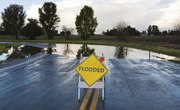Outboard boat motors are notorious for problems. To troubleshoot the engine, go through a series of checks for specific issues that can occur and fix as needed. The most common problem with both two- and four-stroke engines begin with the fuel system.
Warnings
Given this reality, keep a couple of oars handy for if the engine fails while you're out on the water. It also helps to have a citizen's band radio aboard the boat or a cell phone if there is service in the area to contact someone for help if needed.
Mercury Marine, based in Wisconsin, has been making Mercury outboard motors in two- and four-stroke versions ranging from 2.5 to 350 horsepower for more than 75 years, though the company's first motors did not have as much horsepower as some of its current motors. If you have a two-stroke outboard motor, you must add oil to the fuel to lubricate the engine. Four-stroke engines don't need the oil in the engine and are much cleaner machines overall.
Fuel Mixture
All two-stroke engines require that you add a specific oil to the gasoline. The oil-to fuel ratio depends on the requirements of the specific motor. The oil protects and lubricates the engine as well as ensuring a long- life. If you do not mix the oil according to the correct ratio -- which could be 32:1, 40:1 or 50:1 depending on your motor -- you will have problems such as:
- engine won't run, or stalls or bogs
- engine overheats
- or spark plug fouling.
To correct this, empty the fuel tank of all oil. In a clean can containing a gallon of gas, pour in the correct amount of oil. For example, if you require a 32:1 ratio, each gallon of gas requires 4 ounces of the right oil for the motor mixed in. For 40:1, add 3.2 ounces of the correct oil and for 50:1 ratios, mix 2.6 ounces of oil for each gallon of gas.
Remove and clean the spark plug and replace it before pouring the gas back into the fuel tank. Improperly mixed gasoline tends to foul the spark plug as well.
Doesn't Start
When the outboard motor fails to start, verify all of the following:
- Gas in the tank.
- Fuel shutoff valve is on.
- Examine fuel filter for clogs, and fuel line for kinks or leaks.
- Check for a dirty or old spark plug, improper carburetor adjustments, or broken or faulty ignition wires.
- Air vent in fuel cap not open.
- Faulty emergency kill switch.
Some engines -- not the pull-start kind -- have a battery that starts it. If your engine has a battery, make sure it is charged up before use; verify the battery connections are clean -- as corroded connections can keep a Mercury outboard from starting.
Stalling, Power Loss and Excessive Vibration
Outboard motors require that you start them up and hold the gas until they can idle on their own. Once the motor idles on its own, it is warm enough to operate. Stalling, power loss or excessive vibration generally indicates one or more of the following, depending on the specific problem:
- A cold motor
- Incorrect carburetor adjustments
- Contaminated fuel -- or improper fuel-to-oil ratios
- Engine overheating
- Kinked or broken fuel lines.
- Fouled propeller.
- Damaged propeller or broken shear pin.
- Incorrect transom height or placement of motor on boat.
- Fouled boat hull.
- Damaged or worn out spark plugs.
A fouled propeller requires turning the engine off and cleaning the debris from the propeller. But when the motor runs fine, but the boat doesn't go anywhere, it's likely the propeller isn't spinning due to a broken shear pin. The pin is designed to break instead of the propeller when it contact with debris or a stationary object.
If the propeller works, but the boat or motor vibrates excessively, this could be due to a damaged or loose propeller. Verify the blades are free of creaks or breaks; replace damaged propellers with new ones.
Overheating
Outboard motors pull water from the lake, river or ocean through an intake to keep the engine from overheating. Debris in the water can get stuck in the intake and cause the engine to overheat. Check the intake for clogs. Other possible causes of overheating include:
- Improper fuel-to-oil mixture -- not enough oil in the fuel.
- Engine not large enough for the boat and its distributed weight.
- Wrong size carburetor jet or an adjustment making the engine run too lean -- too much air, not enough fuel.
- Engine incorrectly mounted on the boat.
Writer Bio
As a native Californian, artist, journalist and published author, Laurie Brenner began writing professionally in 1975. She has written for newspapers, magazines, online publications and sites. Brenner graduated from San Diego's Coleman College.


